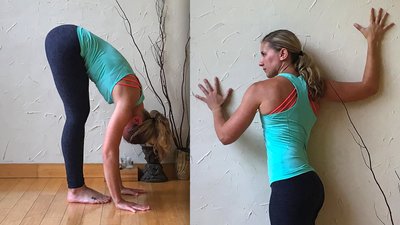If you're dedicated to your professional success, you probably work a lot. And if you have a desk job, that means you probably sit a lot. And if you sit a lot, well, you're probably no stranger to tight hamstrings, tighter hips, and a sore neck.
But long work days aren't the only culprit! We sit in front of a computer, in front of the television, and in the car. The sad fact is, most of us spend more time on our butt than off it. You've probably heard proclamations that "sitting is the new smoking." Even if that isn't exactly the case, you'd better believe that constant sitting takes a toll on your health.
One of the biggest impacts sitting has on your body is that it shortens both the hip flexors and the hamstrings. Over time, the body adapts to this position, and the muscles learn to function in this shortened state. In this case, however, "function" is not synonymous with "works well." Shortened hip flexors pull on the anterior (front) pelvis and shortened hamstrings pull on the posterior (back) pelvis in a game of constant tug of war.
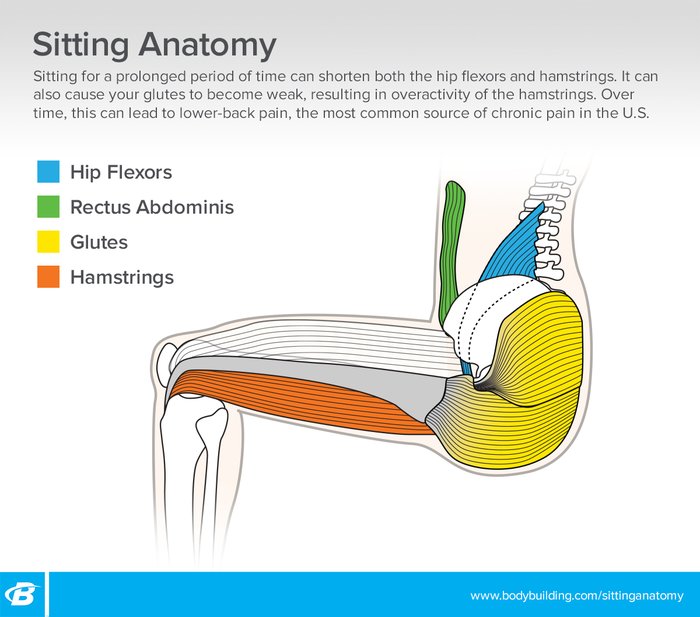
If the hip flexors win, your pelvis may tilt to the front. If the hamstrings win, your pelvis may tilt to the back. The increased tilt of the pelvis in either direction can cause lower-back pain. Lower back pain is one of the most common sources of chronic pain in the U.S. It's also one of the most common reasons people miss work.[1]
Too much seated time also impacts our shoulders, upper back, and chest, especially as that inevitable slouching occurs. As we fatigue, our shoulders roll forward, our upper back rounds, and the muscles in the front of our chest tighten. This can lead to shoulder pain, jaw tightness, and tension headaches.
You may go through years of constant desk dwelling without any issues, but when you finally do feel pain, it's often too late. Pain is a symptom of a problem that has already had a lot of time to develop. To relieve pain, you have to spend some time reversing the damage.
Yoga to the Rescue
To reverse the effects of "oversitting" and relieve the pain that often results, you have to find ways to increase your flexibility and mobility. In a nutshell, you need to move more! A simple and effective way to move more—and in the right ways—is to practice yoga. Yoga is one of the best ways to counterbalance the adverse effects of constant sitting.
For desk jockeys, spending just 5-7 minutes practicing office yoga every couple of hours will make a huge difference in how your body feels throughout the day. As an added perk, even a short stretch session can serve as a mini meditation and lower stress levels.
The yoga poses below focus on those muscles that are most impacted by sitting in chairs: the chest, upper back, hamstrings, hip flexors, and glutes. They can be done at or near your desk—you don't even need a mat. If you work in a cramped office, find a hallway, breakroom, or seldom-used area to turn into your yoga studio.
6 Yoga Poses for Desk Jockeys
Inhale and exhale slowly and evenly through your nose during each pose. Try to hold each pose on each side for one minute. Ease into each pose. There's no reason to stretch as hard as you can immediately. Give your muscles time to react.
1. Standing Cactus
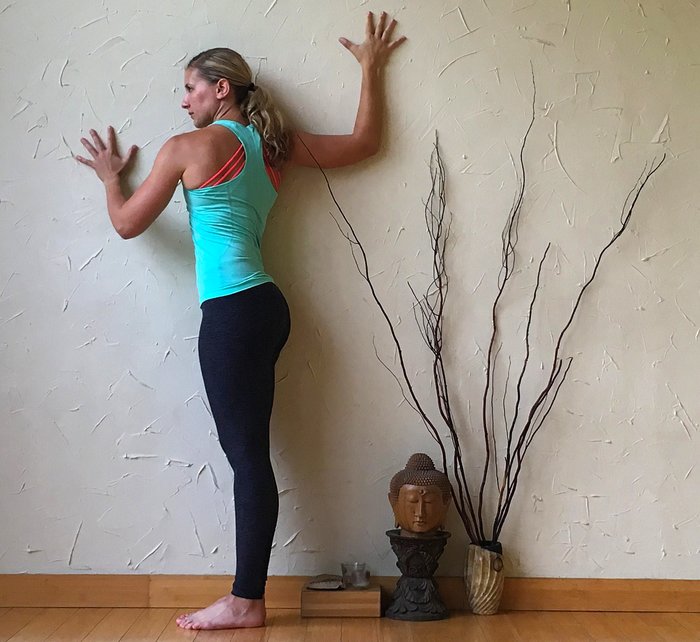
Standing Cactus
Start facing the wall. Place your right forearm on the wall with your right hand in line with your right elbow. Your right elbow should be even with your right shoulder and make a 90-degree angle. Your upper arm should be parallel to the floor. Relax your right shoulder toward the wall, then turn to the left to stretch the other side.
2. Eagle Arms
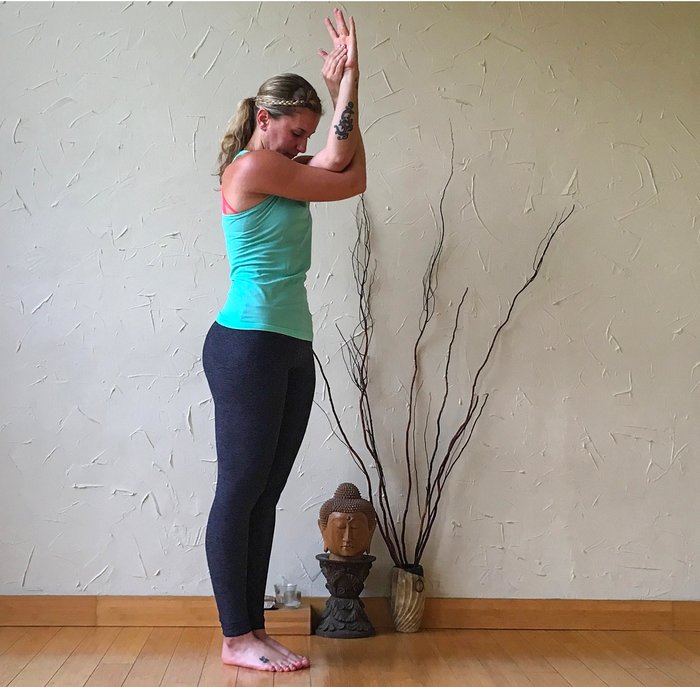
Eagle Arms
Hold your left arm up in front of your face. Swing your right arm so your right elbow moves under your left elbow. Try to wrap your palms around to touch. Relax your shoulders, and lift your elbows off your chest. Move your hands away from your face as you draw your chin down toward your chest. Repeat on the other side.
3. Standing Forward Fold
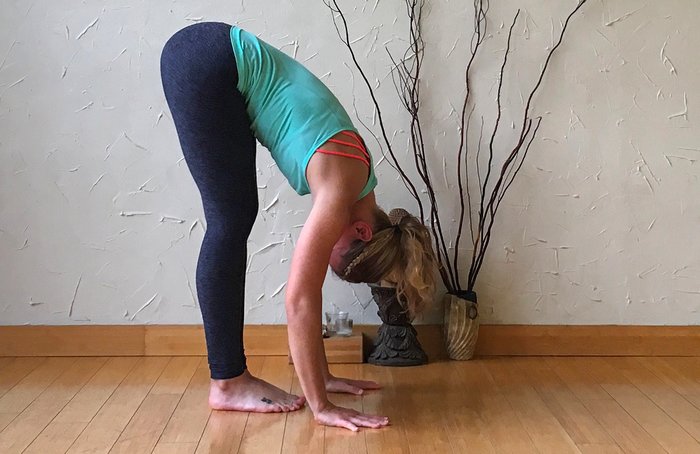
Standing Forward Fold
In addition to stretching your spine, this simple yoga pose also relieves stress. Start with your feet hip-distance apart. Fold forward and reach your hands toward the ground. Rock your weight toward the center of each foot as you shift your tailbone up.
4. Downward Facing Dog
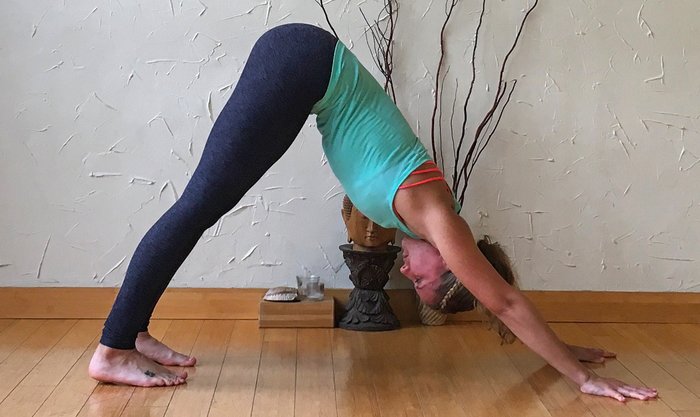
Downward Facing Dog
Start on your hands and knees with your hands shoulder-width apart and your knees under your hips. Tuck your toes, and lift your hips so your arms are extended and your hips are in the air. Try to push your heels toward the ground. Don't worry if your legs aren't perfectly straight.
5. Standing Quad Stretch
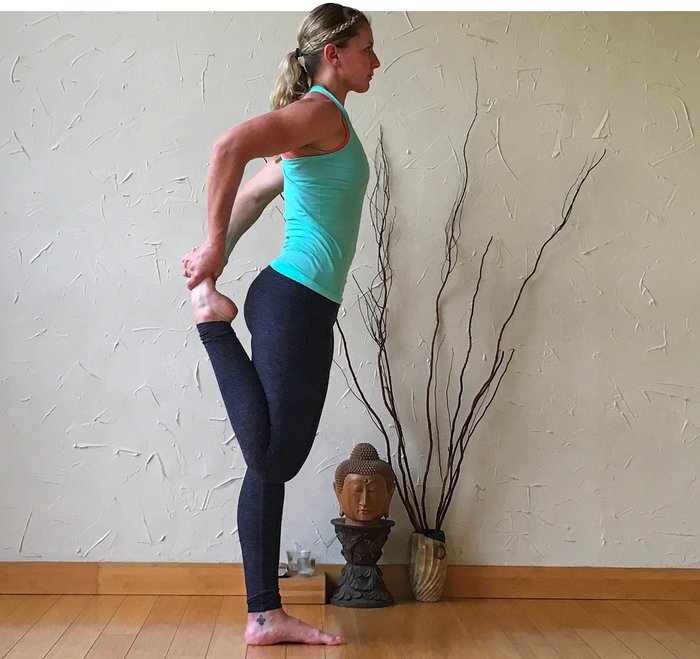
Standing Quad Stretch
This office yoga pose also feels great after a long drive. With your feet together, bend your right knee and grab the top of your right foot with your right hand. Draw your tailbone down, and keep your knees together.
6. Figure Four
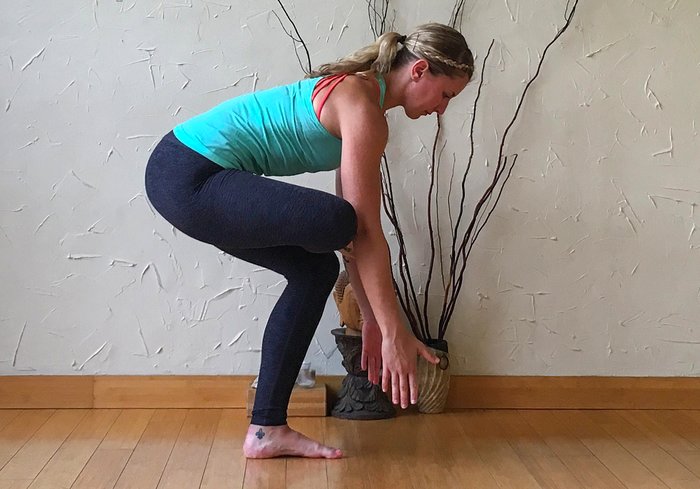
Figure Four
You can do this office yoga pose standing or seated at your desk. It relieves tightness in the glutes and legs, easing tension in the spine. Pick up your right leg and place your right ankle on your left knee. Draw your hips back and down, and fold your upper body forward.
Take a Yoga Break
Try these office yoga poses every couple of hours. Instead of a coffee or cigarette break, get out of your chair and take a yoga break! Aside from helping your pain, a yoga break is a great way to re-energize and refocus during your workday.
Consistent attention to your body and how it moves will not only help relieve the pain you feel, but may help you stay productive and happy at work.
Want more yoga to feel—and look—amazing? Check out Mind Body Fit, the Bodybuilding.com BodyFit Elite program that integrates yoga, workouts, and meditation with follow-along guides and a full nutrition plan.
Reference
- Low Back Pain Fact Sheet. (2015). Retrieved from http://www.ninds.nih.gov/disorders/backpain/detail_backpain.htm

